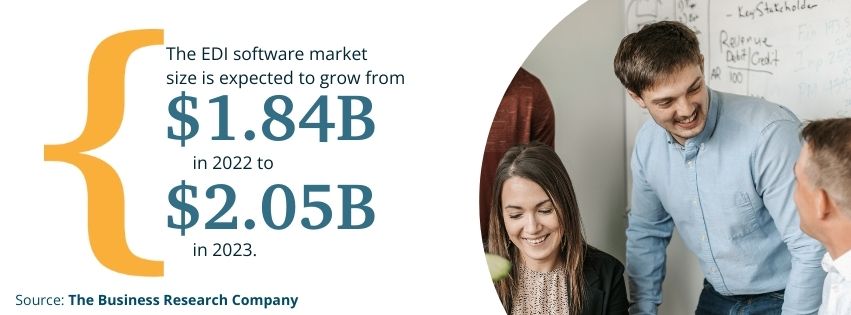Why You Need an EDI-Capable NetSuite ERP to Beat the Competition
You must streamline company processes as much as possible or risk wasting resources. Therefore, you can't overlook the importance of EDI.
Efficiency often determines a business’s success or failure. A sporting goods company may sell the best bicycle on the market. Yet, it could still fold if it wastes significant resources on bad software and slow business processes.
That’s why many companies ensure their primary operating system is EDI capable. Electronic data interchange (EDI) supports exchanging business documents—such as purchase orders, invoices, and shipping notices—between trading partners. It’s an easy way to send and receive large documents in a standardized electronic format.
We understand your business is important, and you don’t have the time to learn the ins and outs of EDI. Let the SuiteDynamics experts do it for you. Our team can integrate your NetSuite ERP with external resources, operations, and systems via EDI.
Read our quick guide below about the importance of EDI capability and schedule your free consultation to make it happen for your company.

Understanding EDI Capability
Electronic Data Interchange (EDI) is a standardized method for exchanging business documents between companies in a structured and computer-readable format. EDI eliminates the need for manual data entry and paper-based communication, reducing errors and enhancing efficiency in supply chain and procurement processes. EDI-capable systems encompass various standards and protocols, such as ANSI X12, EDIFACT, and XML, which define the format and content of electronic documents.
How EDI Relates to NetSuite
NetSuite is a leading cloud-based enterprise resource planning (ERP) system that provides businesses with a comprehensive suite of tools to manage financials, operations, customer relationships, and more. Integrating EDI capability with NetSuite is crucial for companies that want to optimize their order-to-cash and procure-to-pay processes. This integration allows for real-time data exchange between NetSuite and trading partners, streamlining operations, and reducing manual data entry.
What Is a NetSuite Integration?
A NetSuite integration connects NetSuite with other software systems, applications, or external data sources to enable seamless data exchange and workflow automation. A NetSuite EDI integration involves linking your NetSuite ERP with EDI systems or providers to facilitate the exchange of electronic documents with trading partners.
Key Benefits of Becoming EDI Capable
Companies implement NetSuite EDI integrations to boost their productivity in various ways.
1. Increased Efficiency
One of the primary advantages of an EDI-capable system is the significant boost in operational efficiency. By automating the exchange of documents such as purchase orders, invoices, and shipping notices, businesses can reduce the time and effort required to process transactions. This streamlining, in turn, leads to faster order fulfillment, reduced lead times, and lower administrative costs.
2. Error Reduction
Manual data entry is prone to errors, causing costly mistakes and disruptions in supply chain processes. EDI capability minimizes the risk of errors by automating data transmission and validation.
3. Improved Accuracy and Data Quality
EDI capability ensures data consistency and accuracy by adhering to predefined standards and formats. This consistency enhances data quality and reduces discrepancies between trading partners, leading to better decision-making and stronger business relationships.
4. Enhanced Visibility and Reporting
EDI-capable systems provide real-time visibility into transaction statuses, inventory levels, and order processing. This visibility enables businesses to monitor and manage their supply chains more effectively, anticipate potential bottlenecks, and make informed decisions.
5. Cost Savings
EDI capability saves significant costs by reducing the need for paper-based processes, manual data entry, and error correction.
6. Faster Partner Onboarding
EDI streamlines the process of onboarding new trading partners, eliminating the need for custom integrations and manual data exchange protocols. This efficiency expedites collaboration with new suppliers and customers, allowing businesses to expand their networks more rapidly.
Discover how an EDI-capable ERP can further benefit your company in a free consultation with SuiteDynamics experts.
Considerations for NetSuite EDI Integration
NetSuite EDI integration isn’t as simple as writing a few lines of code and connecting pieces of software. You must consider several factors.
1. Integration Method
Multiple methods exist to achieve EDI capability, including point-to-point connections, third-party integration platforms, and NetSuite SuiteTalk API. Evaluate which way aligns best with your business requirements and technical capabilities.
2. Trading Partner Requirements
Different trading partners may have specific EDI standards and communication protocols they prefer. Ensure your integration solution supports the required formats and protocols.
3. Data Mapping and Transformation
Data mapping and transformation are critical aspects of an EDI-capable system. You need to ensure that NetSuite data aligns with your trading partners' format and requirements.
4. Data Validation and Error Handling
Implement robust data validation and error handling mechanisms to prevent data discrepancies and ensure smooth operations.
5. Security and Compliance
If applicable, protect sensitive data by implementing robust security measures and ensuring compliance with industry-specific regulations, such as HIPAA or GDPR.
6. Scalability
Choose an integration solution that can scale with your business, accommodating increased transaction volumes and new trading partners.
Your company must have an EDI-capable ERP to maintain efficiency, so you have to get the EDI implementation right. SuiteDynamics experts will talk you through these considerations and more during your free consultation.
How to Boost Your Business with EDI
A NetSuite EDI Integration is a powerful tool. It can enhance supply chain and procurement processes' efficiency, accuracy, and compliance. Yet, you must understand EDI capability and its relation to NetSuite to harness this technology’s full potential.
We know your company should focus on sales and customer relationships instead of diving into IT details. SuiteDynamics experts will forge comprehensive EDI connections that help your company transfer sales orders, update fulfillments, send invoices, and more. Then, your team can put your energy where it counts.
Discover how to maximize your NetSuite ERP so your company can thrive in modern commerce.
We pull information from NetSuite material, SuiteDynamics experts, and other reliable sources to compose our blog posts and educational pieces. We ensure they are as accurate as possible at the time of writing. However, software evolves quickly, and although we work to maintain these posts, some details may fall out of date. Contact SuiteDynamics experts for the latest information on NetSuite ERP systems.
Part of this text was generated using GPT-3, OpenAI’s large-scale language-generation model. After generating the draft language, our team edited, revised, and fact-checked it to ensure readability and accuracy. SuiteDynamics is ultimately responsible for the content of this blog post.












